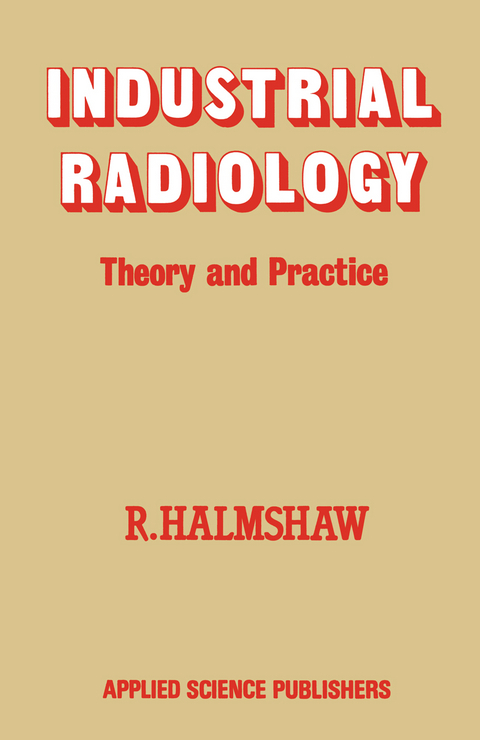
Industrial Radiology
Springer (Verlag)
978-94-009-7342-8 (ISBN)
1. Principles of Radiology.- 2. Basic Properties of Ionising Radiations.- 2.1. Nature of X-Rays and Gamma-Rays.- 2.2. Units.- 2.3. Atomic Structure.- 2.4. Generation of X-Rays.- 2.5. Gamma-Rays.- 2.6. Absorption.- 2.7. Absorption Coefficient.- 2.8. Absorption Curves.- 2.9. Scattered Radiation and Radiographic Sensitivity.- 3. X-Ray Sources.- 3.1. Introduction.- 3.2. The X-Ray Spectrum.- 3.3. X-Ray Tubes and Generators.- 3.4. X-Ray Generator Circuits.- 3.5. High Energy X-Ray Equipment.- 3.6. X-Ray Tube Mountings.- 3.7. Portable Tank-Type X-Ray Sets.- 3.8. Controls for X-Ray Equipment.- 3.9. Comparison of X-Ray Generators.- 4. Gamma-Ray Sources And Equipment.- 4.1. Radioactivity.- 4.2. Definitions.- 4.4. Specific Isotopes for Radiography.- 4.5. Radioactive Source-Handling Equipment.- 4.6. The Use of Gamma-Ray Sources.- 5. The Recording of Radiation.- 5.1. Introduction.- 5.2. The Photographic Effect.- 5.3. Ionisation.- 5.4. Scintillation Counters.- 5.5. Semiconductor Devices.- 5.6. Fluorescence.- 6. Radiographic Techniques—Principles.- 6.1. Introduction.- 6.2. Equipment Data.- 6.3. Image Parameters.- 6.4. Choice of Radiation Energy.- 6.5. Films and Intensifying Screens.- 6.6. Filtration.- 6.7. Masking.- 6.8. Scattered Radiation.- 6.9. Techniques to Cover a Range of Specimen Thickness (Thickness Latitude).- 6.10. Specimen Positioning.- 6.11. Marking: Identification.- 6.12. Other Practical Considerations.- 6.13. Special Techniques.- 7. Radiographic Techniques—Sensitivity.- 7.1. Introduction.- 7.2. Definition of Terms.- 7.3. Image Quality Indicators (IQI).- 7.4. Viewing Conditions.- 7.5. Codes of Recommended Good Practice.- 7.6. Special Techniques.- 8. Sensitivity Performance.- 8.1. Introduction.- 8.2. Attainable IQI Values.- 8.3. The Calculation of Detail Sensitivity.-8.4. Flaw Sensitivity.- 8.5. Defect Depth Determination.- 8.6. Radiographic Imaging Considered in Terms of Spatial Frequencies.- 8.7. Noise Limitations.- 8.8. Information Theory.- 8.9. Densitometrie Analysis.- 8.10. Reliability of Performance.- 9. Interpretation of Radiographs.- 9.1. Introduction.- 9.2. General Aspects.- 9.3. Weld Radiographs.- 9.4. Radiographs of Castings.- 9.5. Non-Metallic Materials.- 9.6. Reference Radiographs.- 9.7. Acceptance Standards for Defects.- 9.8. Assemblies.- 9.9. Reporting Results.- 9.10. Copying Radiographs.- 10. Safety Problems in Radiology.- 10.1. Introduction.- 10.2. Radiation Sources.- 10.3. Radiation Units.- 10.4. Permissible Dose Limits.- 10.5. Radiation Monitoring Equipment.- 10.6. Protection Data.- 10.7. Calculation of Protective Barrier Thicknesses.- 10.8. Gamma-Ray Source Containers.- 10.9. General Safety Requirements for Radiographic Laboratories.- 11. Fluoroscopy, Image Intensifiers and Television Systems.- 11.1. Introduction.- 11.2. Image Intensifier Tubes.- 11.3. Television—Fluoroscopic Systems Performance.- 11.4. Applications.- 11.5. Future Developments.- 12. Special Methods.- 12.1. Introduction.- 12.2. Neutron Radiography.- 12.3. Proton Radiography.- 12.4. Electron Radiography.- 12.5. Microradiography.- 12.6. Autoradiography.- 12.7. Flash Radiography.- 12.8. Radiometric Methods.- 12.9. Digitised Images: Image Processing.
| Zusatzinfo | 76 Illustrations, black and white; XII, 330 p. 76 illus. |
|---|---|
| Verlagsort | Dordrecht |
| Sprache | englisch |
| Maße | 140 x 216 mm |
| Themenwelt | Schulbuch / Wörterbuch |
| Geisteswissenschaften | |
| Naturwissenschaften | |
| Sozialwissenschaften | |
| ISBN-10 | 94-009-7342-X / 940097342X |
| ISBN-13 | 978-94-009-7342-8 / 9789400973428 |
| Zustand | Neuware |
| Haben Sie eine Frage zum Produkt? |
aus dem Bereich


